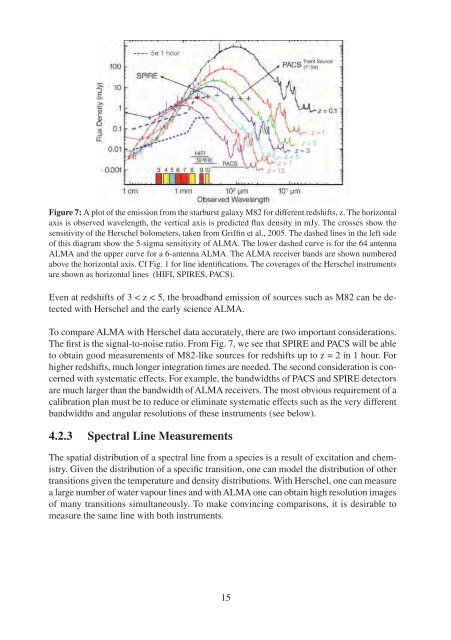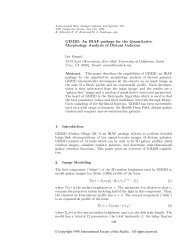4 Comparison of the ALMA and Herschel - ESO
4 Comparison of the ALMA and Herschel - ESO
4 Comparison of the ALMA and Herschel - ESO
Create successful ePaper yourself
Turn your PDF publications into a flip-book with our unique Google optimized e-Paper software.
Figure 7: A plot <strong>of</strong> <strong>the</strong> emission from <strong>the</strong> starburst galaxy M82 for different redshifts, z. The horizontal<br />
axis is observed wavelength, <strong>the</strong> vertical axis is predicted flux density in mJy. The crosses show <strong>the</strong><br />
sensitivity <strong>of</strong> <strong>the</strong> <strong>Herschel</strong> bolometers, taken from Griffin et al., 2005. The dashed lines in <strong>the</strong> left side<br />
<strong>of</strong> this diagram show <strong>the</strong> 5-sigma sensitivity <strong>of</strong> <strong>ALMA</strong>. The lower dashed curve is for <strong>the</strong> 64 antenna<br />
<strong>ALMA</strong> <strong>and</strong> <strong>the</strong> upper curve for a 6-antenna <strong>ALMA</strong>. The <strong>ALMA</strong> receiver b<strong>and</strong>s are shown numbered<br />
above <strong>the</strong> horizontal axis. Cf Fig. 1 for line identifications. The coverages <strong>of</strong> <strong>the</strong> <strong>Herschel</strong> instruments<br />
are shown as horizontal lines (HIFI, SPIRES, PACS).<br />
Even at redshifts <strong>of</strong> 3 < z < 5, <strong>the</strong> broadb<strong>and</strong> emission <strong>of</strong> sources such as M82 can be detected<br />
with <strong>Herschel</strong> <strong>and</strong> <strong>the</strong> early science <strong>ALMA</strong>.<br />
To compare <strong>ALMA</strong> with <strong>Herschel</strong> data accurately, <strong>the</strong>re are two important considerations.<br />
The first is <strong>the</strong> signal-to-noise ratio. From Fig. 7, we see that SPIRE <strong>and</strong> PACS will be able<br />
to obtain good measurements <strong>of</strong> M82-like sources for redshifts up to z = 2 in 1 hour. For<br />
higher redshifts, much longer integration times are needed. The second consideration is concerned<br />
with systematic effects. For example, <strong>the</strong> b<strong>and</strong>widths <strong>of</strong> PACS <strong>and</strong> SPIRE detectors<br />
are much larger than <strong>the</strong> b<strong>and</strong>width <strong>of</strong> <strong>ALMA</strong> receivers. The most obvious requirement <strong>of</strong> a<br />
calibration plan must be to reduce or eliminate systematic effects such as <strong>the</strong> very different<br />
b<strong>and</strong>widths <strong>and</strong> angular resolutions <strong>of</strong> <strong>the</strong>se instruments (see below).<br />
4.2.3 Spectral Line Measurements<br />
The spatial distribution <strong>of</strong> a spectral line from a species is a result <strong>of</strong> excitation <strong>and</strong> chemistry.<br />
Given <strong>the</strong> distribution <strong>of</strong> a specific transition, one can model <strong>the</strong> distribution <strong>of</strong> o<strong>the</strong>r<br />
transitions given <strong>the</strong> temperature <strong>and</strong> density distributions. With <strong>Herschel</strong>, one can measure<br />
a large number <strong>of</strong> water vapour lines <strong>and</strong> with <strong>ALMA</strong> one can obtain high resolution images<br />
<strong>of</strong> many transitions simultaneously. To make convincing comparisons, it is desirable to<br />
measure <strong>the</strong> same line with both instruments.<br />
15




